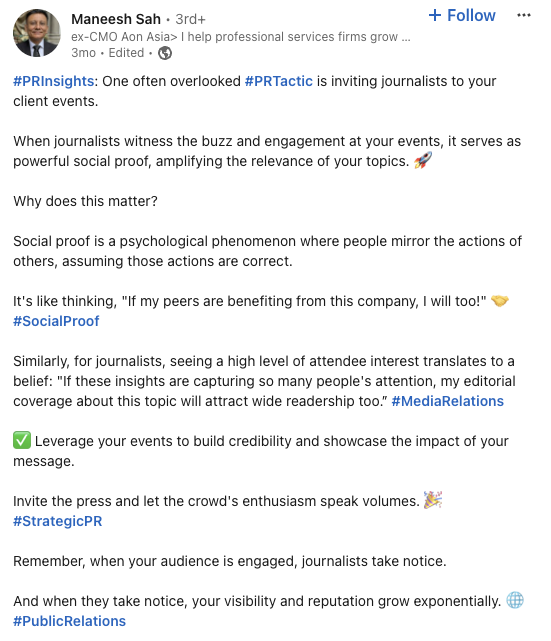Are you hosting a virtual event for your brand? You're not alone - online events have become hugely popular for connecting with industry pros, potential clients, and media. In fact, did you know over 75% of people prefer virtual events because they're so easy to attend?
With geography no longer a barrier, virtual events help your brand storytelling reach a wider audience than traditional in-person events, while being far more budget-friendly. And there are plenty of good reasons to host a virtual event – from tying into key dates on the calendar and new product launches to interesting research and industry thought leadership.

But in an increasingly crowded online space, how do you make your virtual event stand out? Let’s cover the essentials first.
Laying the Groundwork for Your Virtual Event
Before thinking about how to stand out, you’ll need to lay the proper foundation for your event:
- Set Clear Goals: What is the purpose for holding this event? What do you want to result from it? Are you aiming for lead generation, increased brand awareness, new product sales, or building industry relationships? Defining your goals will help you determine the right format, content, timing, and speakers, as well as what metrics to track to determine if the event was successful.
- Rally Your Team: Virtual events require a team effort to be successful. Don’t wait until the last minute to connect with your colleagues and stakeholders to get everyone on board. Be sure to level-set on roles and responsibilities, expectations, and expected attendance. You’ll inevitably need (and want) support from marketing, sales, marketing operations, and others to help garner interest and host a seamless event.
- Know Your Audience: What topics are most relevant and interesting to your audience? What content and speakers will they value? Look at metrics from previous events (How much engagement did the topic get? What kind of questions were asked during the event?). Refer to feedback you’ve gotten from past events (for instance, if you surveyed attendees for their thoughts on the event and what future topics they’d be interested in). Social listening and media monitoring can also help you understand the topics that are top of mind for your target audiences. Get input from other teams like sales and customer experience, who have a pulse on the content clients and customers are asking for.
You’ll want to find a balance between what the audience wants and what you’re trying to achieve. For example, if you’re focusing on a new product, highlight the pain points it’s solving for the audience and hold back the strong-arm sales pitch to keep them invested in your event’s content. - Choose the Right Format: Is it informational or experiential? Webinars, conferences, networking events, Q&As, product launches, investor days, wellness events, and competitions – the options are endless. With your goals and audience in mind, decide on the format that will work best. See the next section for more details on different types of virtual events to consider.
- Give Yourself Enough Time: Don’t cut corners here. You’ll need enough lead time to handle logistics, planning, prep, and promotion across multiple channels, as well as pitching to media partners to generate earned coverage for your event.
- Offer a Recording: Always record and make the content available on-demand after the live event concludes. Be sure to let people know in advance so they don’t skip registration.
- Test & Rehearse: Avoid any hiccups by testing everything from the registration process to your event technology. And don’t skip rehearsals – they set the stage for your speakers while giving you time to iron out any kinks.
Different Types of Virtual Events
Virtual events come in all shapes and sizes. Here are some of the most popular options:
- Webinars: Educational presentations on industry trends or product-related topics (Bonus tip: Turn your webinar into a ”lunch and learn” by providing attendees with food vouchers or gift cards.)
- Product Launches: Unveil new offerings through live streams or pre-recorded videos
- Experiential Event: Focus on creating a memorable experience tied to your brand (e.g., wine/beer tasting with an expert, book club discussion, interactive group chats, art classes, etc.)
- Conferences: Multi-day events with keynote speakers, breakout sessions, and networking
- Trade Shows: Set up virtual booths, product demonstrations, and interactive exhibits
- Live Q&A Sessions: Let customers talk directly with company experts or leadership
- Workshops or Masterclasses: Hands-on learning experiences to showcase product capabilities or industry expertise
- Panel Discussions: Bring together thought leaders to discuss industry issues
- Virtual Tours: Showcase facilities, manufacturing processes, or behind-the-scenes operations
- Hackathons or Competitions: Engaging developers or customers to solve problems using the company's products
- Livestreamed Interviews: Host conversations with industry influencers or company executives
- Roundtables: Small group discussions on specific topics
- Virtual Happy Hours or Networking Events: Informal gatherings to build relationships with clients or partners
- Online Fundraisers: Host charity events or crowdfunding campaigns
4 Tips to Making Your Event Stand Out
With the basics covered, let’s look at four ways to make your virtual event truly stand out.
Investing in the human side of people in virtual events fosters genuine connections, enhances engagement, and creates a more memorable and impactful experience for all participants.
- Samantha Ranieri, Senior Field Marketing Manager, Cision
1. Keep Their Attention
With people’s attention spans growing shorter by the day, combatting screen fatigue is priority number one. Aim for bite-sized 20-minute presentations if just one speaker. For longer, multi-session events:
- Break it up into segments like morning/afternoon or themed tracks
- Change moderators to keep things fresh
- Incorporate interactive elements like live chat, polls, Q&As, and multimedia
- Create a hashtag and encourage live posts during the event
- Add experiential interludes between presentations
- Offer food vouchers or gift cards to make it easier for people to attend and stay engaged (This can be a particularly effective move as it removes stress and adds an element of delight.)
Research shows Q&A sessions engage 78% of attendees, while polls are one of the most common participation tools.
2. Share Unique, Valuable Content
Why do 80% of people attend virtual events? Educational content. Your event’s content needs to provide true value they can’t get elsewhere, like:
- Exclusive data or research
- A diverse range of thought leaders or speakers
- Unique insights only your brand can offer
With no geographical limits, you can bring in national or global speakers to offer a fresh perspective or regional context. This may be more important than you think: The quality of your speakers significantly influences 64% of attendees’ decision to attend.
3. Build Pre-Event Buzz
To make sure your event is successful, get people excited beforehand! Build anticipation through:
- Social media teasers and pre-event content (example from our recent webinar below)
- Collaborative agendas where attendees can submit questions/comments in advance
- Email newsletters highlighting what’s in store
- Send reminder emails leading into the event
- Pitch to earn media coverage for your virtual event (more on that below)
- Partner with internal communications and sales teams to help spread the word
- Physical event kits

Generating early excitement helps make attendees feel valued and invested from the start.
4. Keep the Momentum Going
While your event itself is a point in time, the engagement doesn’t have to be. Consider these methods to build a community and maximize the impact of your event:
Follow-Up Strategy
When putting in the hard work to plan and orchestrate a virtual event, don’t forget your post-event strategy, including:
- Send an email with the recording and resources, adjusting the message for each audience – registrants and non-registrants, attendees and those that missed the event.
- Solicit attendee feedback via survey to inform future content (and show them you're invested in giving them a good experience).
- Invite your audience to stay connected via social media and in any online event-specific forums you’ve created.
- If your event was experiential, be sure to include resources that tie back to the theme (e.g. if you held a beer/wine tasting, share interesting or seasonal cocktail recipes).
Repurpose and Refine
With just a bit of tweaking, you can repurpose your event content into:
- Blog posts (event recap, key takeaways, Q&A highlights)
- Guide or tip sheet combining takeaways from multiple sessions or deeper dives on a specific topic covered
- Social media posts (video clips, visual quotes)
- Email campaign promoting on-demand content from the event
- Bylined article to pitch to publications
- Podcast series discussing content from event (interviews with speakers, feature additional experts)
- Part II follow-up event
Community Spaces
Create dedicated online spaces where attendees can connect before, during, and after the event (e.g., Slack, Facebook/LinkedIn Groups, Reddit Forums). Having a strong community keeps interest high and relationships going long after your event ends.
Pitching Your Virtual Event
If a brand hosts an event and no media cover it, does it make an impact? Of course it does, but getting earned coverage amplifies your reach and message even further.

The good news? Forty-four percent of reporters say they want access to events (according to the State of the Media Report), so their interest is high. The key lies in smart targeting and a personalized pitch.
Find the Right Media Partners
The right media partners are the ones that cover your industry, whose audience will find value in the information you’re presenting. A comprehensive media database, like CisionOne, can help curate your list of relevant journalists and influencers with keyword searches and advanced filtering options based on sector, beats, outlets, etc. If the event isn’t relevant to the media contact and their audience, don’t waste their time or yours on the next step - pitching.
Perfecting Your Pitch
Perfecting a pitch relies on personalization. Show that you’ve done your research and that you understand the journalist, as well as their audience. Tailor your pitch to highlight explain the “So what?” for their audience – why is this information important, timely, and valuable? Be sure to include the details – date/time, agenda, and speaker lineup – and offer interview opportunities with the hosts or speakers.
With a thoughtful approach to media outreach, you can secure coverage that maximizes your event's impact. For more advice on pitching, check out these resources:
- How to Create the Perfect PR Pitch, According to Journalists
- 10 Media Pitching Tips
- 7 Types of PR Pitches (And How to Nail Each One)
- How to Write a Media Pitch + 5 Pitch Examples That Actually Got Published
- Mastering the Pitch: Data-Backed Strategies for Smarter PR
Bottom Line
Virtual events hold amazing potential for brands - from connecting with new audiences to solidifying their position as industry thought leaders. But in an oversaturated online landscape, creating an experience that genuinely stands out is critical – and bringing in the human element is key.
Find out how CisionOne, our all-in-one PR platform, can help take your virtual events to the next level - from pinpointing the perfect media partners to spotting hot industry trends. Speak to an expert today.








